Here’s a brief look at the Sony 300mm F/2.8 SSM G lens. Scroll down for the main review.
|
Lens
|
SAL-300F28G Sony 300mm F/2.8 SSM G. Discontinued in 2012
|
|
Box contents
|
Contents inside box are; nice metal clad trunk, padded on the inside with keys, Carbon fiber lens hood, vinyl cover for hood with cord, carrying strap for trunk, carrying strap for lens, drop-in 42mm polarizing filter with vinyl case and the rear cap.
|
|
Cost
|
|
|
Build quality
|
Superb
|
|
Additional information
|
The second most expensive Sony lens to date. This lens is a rebadged Minolta from around 2003.
|
Specifications below
|
|
|
Optical configuration
|
13 elements in 12 groups, drop-in filter included in element count.
|
|
Angle of view
|
8° 10′ full frame, 5° 20′ APS-C.
|
|
Aperture
|
9 blades, curved
|
|
Full frame and APS-C
|
Yes, full frame and APS-C. APS-C equivalent, 450mm
|
|
Depth of field and focus scales?
|
Focus distance window, with DOF hash marks at F/32
|
|
Minimum focus, image plane to subject
|
79″ (2000mm)
|
|
Minimum focus, end of lens barrel to subject
|
65.6″ (1666mm)
|
|
Hard stop at infinity focus?
|
No
|
|
Length changes when focusing?
|
No |
|
Focus ring turns in AF?
|
No
|
|
Filter size
|
Exclusive use 42mm drop-in.
|
|
Filter ring rotates?
|
No
|
|
Distance encoder?
|
Yes
|
|
Max magnification
|
0.18x, or 1:5.6
|
|
Min. F/stop
|
F/32
|
|
Sony teleconverter compatible?
|
Yes
|
|
Length changes when zooming?
|
N/A
|
|
Dimensions WxL (my measurements)
|
4.8″ x 9.53″ 122mm x 242mm. Widest at inner hood mounting ring. Hood is 5.35″ (136mm) wide. Front element itself is 4.15″ (106mm) wide.
|
|
Maximum extended length (my measurements)
|
14.3″ (364mm) with hood attached.
|
|
Weight bare (my scale)
|
Bare; 5lbs, 2oz (2325g), no caps or tripod collar, but includes built-in 42mm filter. In-use, includes lens, hood, and tripod collar; 5lbs, 15oz (2690g). Stored; (lens, filter, hood and caps) 6lbs, 3oz (2815g) Hood is 7.0oz (198g). Front vinyl cover is 4.3oz, (122g) and tripod collar is 6.0oz, (170g).
|
Requisite product shots.
 |
| Box, lens and hood |
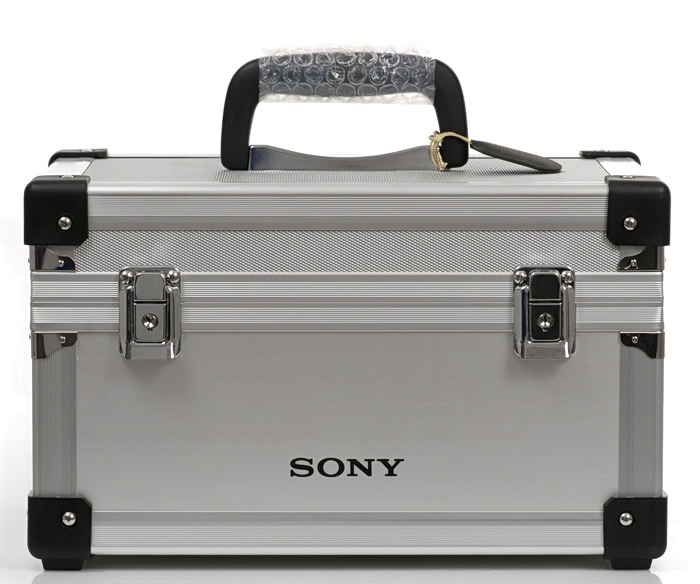 |
| Nice metal padded trunk with keys and bubble wrapped handle |
 |
| Inside trunk |
 |
| Included accessories |
 |
| Polarizer filter with pouch |
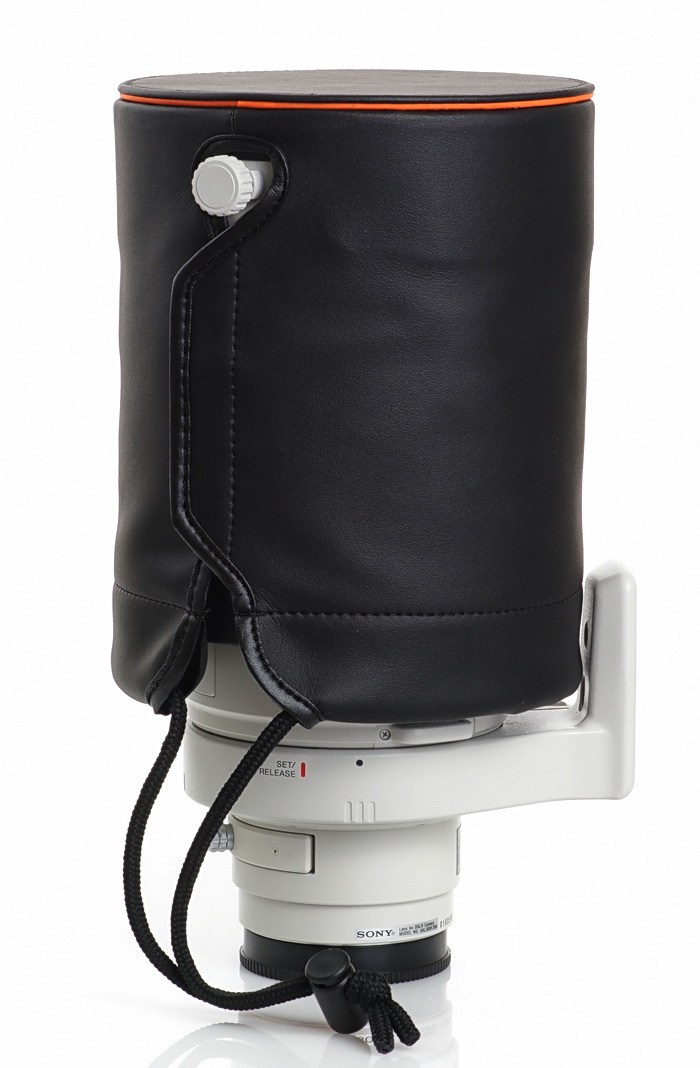 |
| lens, hood and front/hood cover |
 |
| Front element |
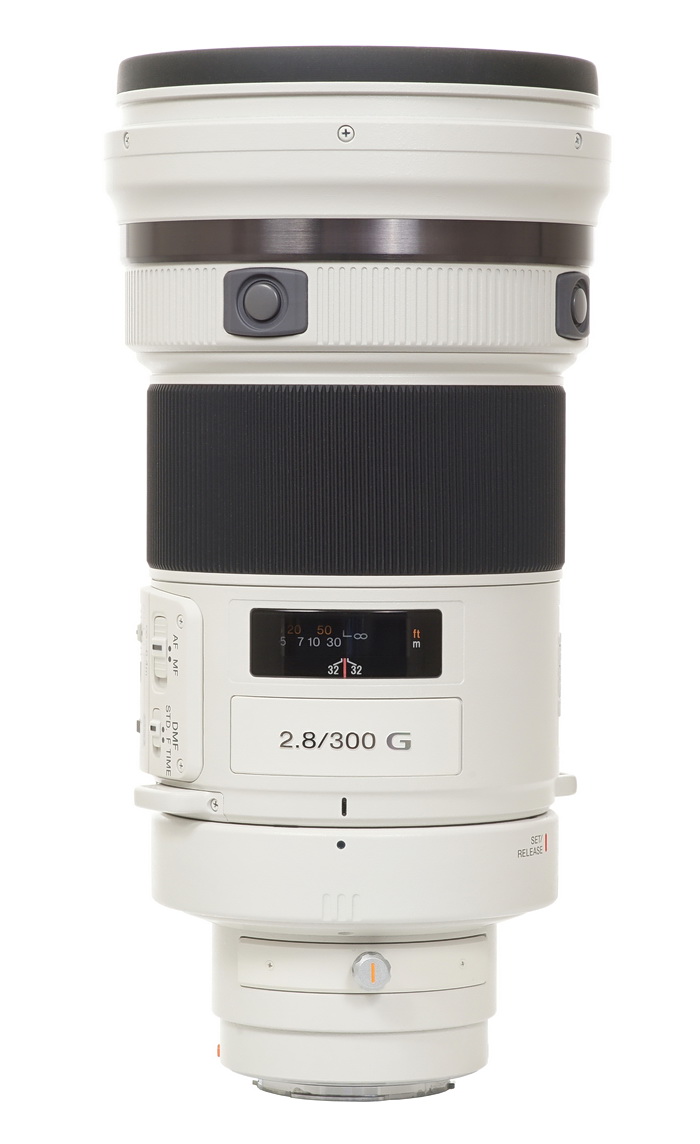 |
| Front or top |
 |
| Backside mount |
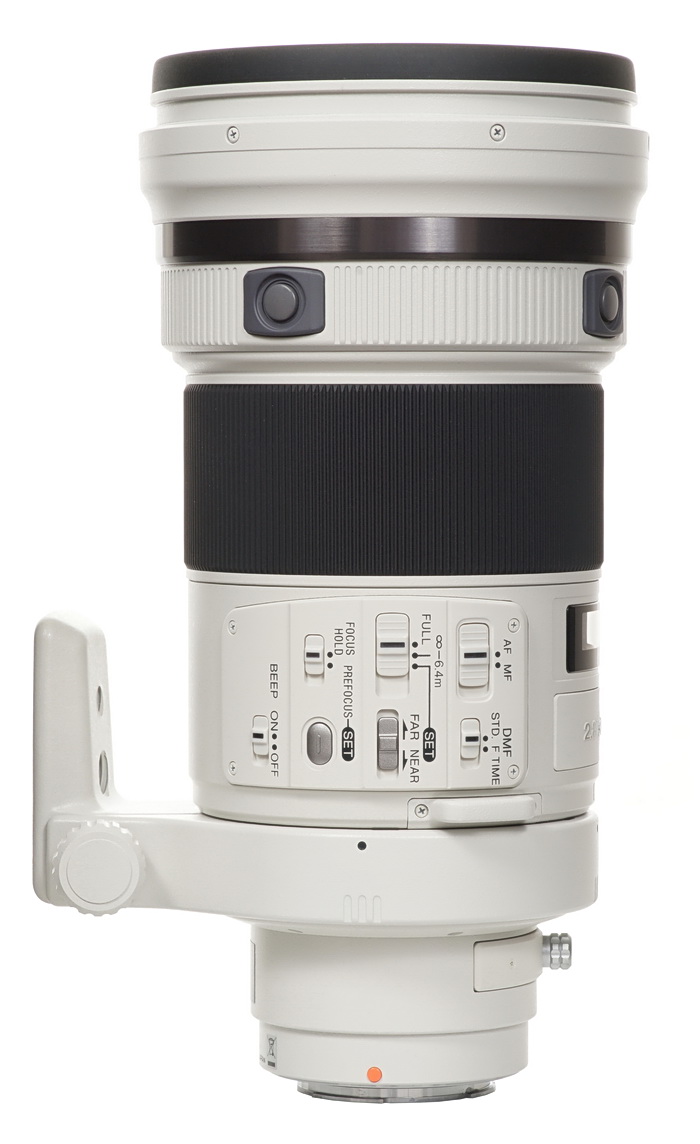 |
| Side with control panel |
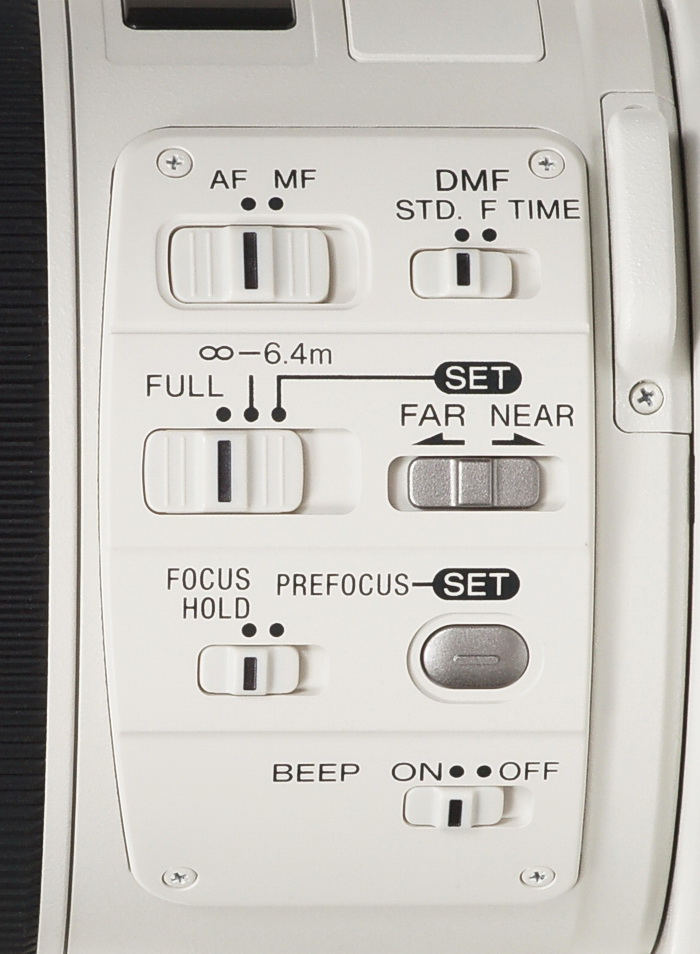 |
| Control or switch panel |
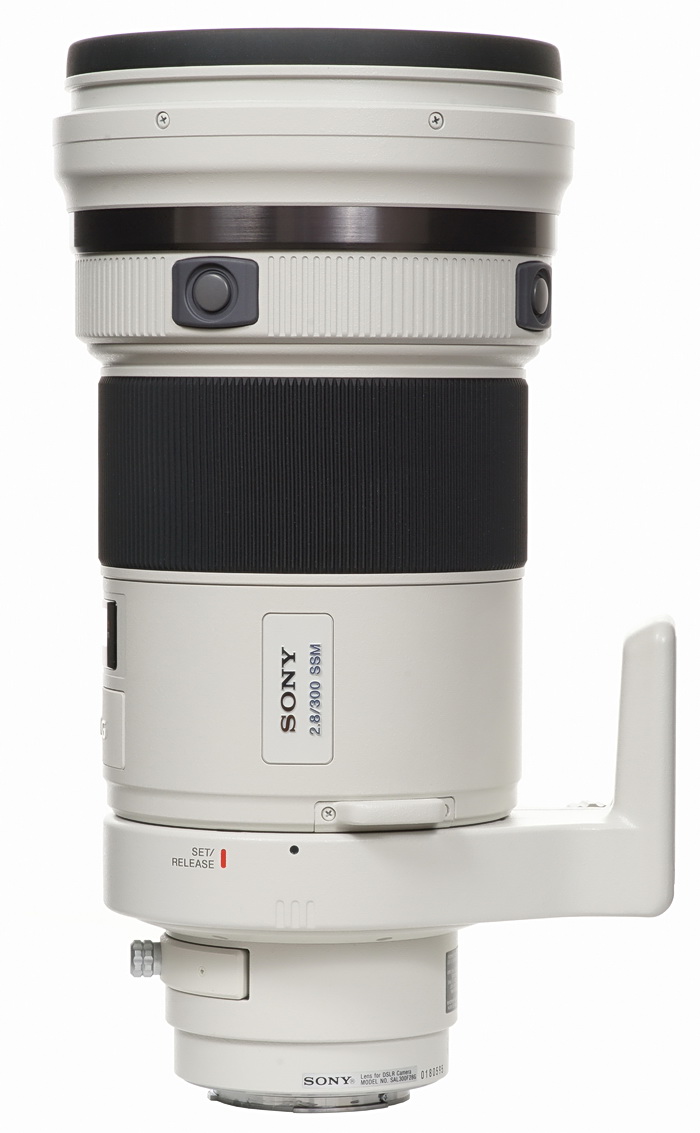 |
| Right side |
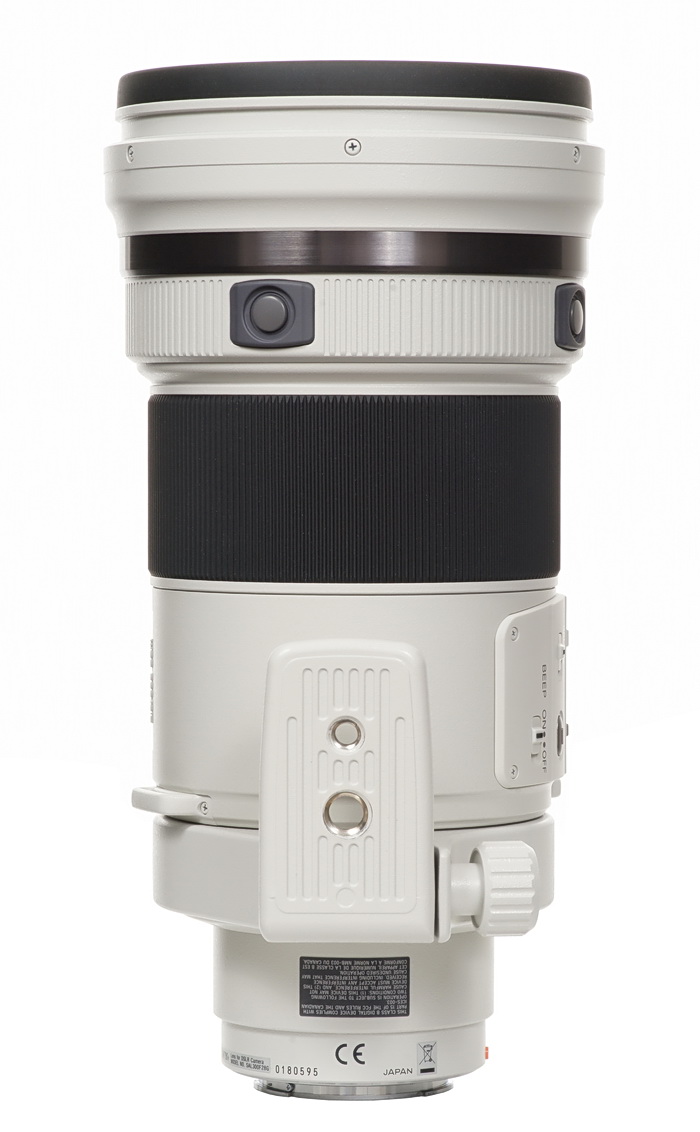 |
| Bottom |
 |
| X-ray view |
 |
| MTF chart from Sony |
The
Sony A700 and
A900 were used for this review. For full frame results, go to the bottom of the page. For a better understanding of terms and methods used in this review,
go here.
This 300mm telephoto lens (made in Japan) features a fast aperture of F/2.8 with a very good build quality. Sony claims the barrel and some other components are made of magnesium for weight reduction, so when you’re done with this lens, please do not dispose of it by throwing it in the fireplace or burning barrel. Even with that weight saving material, it’s still very heavy, although a person could hand hold the lens for a short period of time well enough. Having it hang around your neck all day is a different story.
The Sony 300mm F/2.8 SSM G is a rebadged Minolta from 2003.
The Sony 300mm F/2.8 SSM G has some handy features on it. For starters, it has four focus hold buttons around the barrel at the front, which can be changed to DOF preview (or prefocus position) on certain cameras. It also has a fully adjustable and removable tripod collar for when you want to hand hold it, or rotate it on a tripod. There are some strap lugs, and you’ll want to use these as holding or carrying the lens by the camera or camera strap will eventually damage the mount on either the camera or lens due to the weight. You may notice the rather large switch panel on the left side, a detailed view is in the product shots above. This panel controls focusing, and there are plenty of options, but more on that below. The Sony 300mm F/2.8 SSM G has a very light-weight carbon fiber hood, this type of hood is not only different in construction, but different in the way it mounts as compared to the older Minolta prime telephoto lenses. Instead of three lugs and a screw (like the old Minolta lenses), you now have a plastic insert at the hood base, which fits flush nearly all the way around the lens barrel channel, and locks by turning the screw, there’s no spring involved. The hood stays nice and tight, and doesn’t want to rotate and scratch the inner channel as the old style could do.
The front element seems very flat and is probably more of a protective device than being optically important, at least that’s my opinion.
In the box is the lens, a carbon fiber hood with a nice felt-type anti-glare covering on the inside and a rubber gasket around the front; a locking metal trunk with nice padding on the inside for the lens and a set of keys; a vinyl front cover (fits over hood); a 42mm polarizer with holder and case, and a 42mm “normal” drop-in filter in the lens; finally, a strap for the metal case and a strap for the lens.
Just for fun. Don’t lose the fancy carbon fiber lens hood, because replacing it will cost you a cool $1368.95!! If you think I’m full of it, here is the Sony part number: A1204659A, check it yourself. The nice trunk case is $355.95. How about the vinyl cover for the lens, $112.95. Should you lose the 42mm normal filter and holder; expect to pay $127.98 for the filter and $112.01 for the holder.
Focusing. The wide focusing ring is at the middle-to-front of the lens, and does not turn during auto-focusing, thankfully. Manual focusing takes just over 1/3 turn from Close-in to infinity, and doesn’t add any length to the lens. SSM focusing works as an over-drive system, that is the focusing ring turns faster than the actual mechanism in the focus distance window, this allows for more precise manual focusing. AF speed is fairly fast and accurate most of the time, although it isn’t as good as I would like considering the cost of the lens. I’d say it performs about the same as the Sony 70-400mm. There are four focus hold buttons placed around the barrel and are easily accessible in any orientation. On select camera bodies you can change the buttons to DOF (depth of field) preview or prefocus, as described below.
I noticed a quirk in the focusing method during my use. While trying to focus, it turns somewhat slowly at first, then when it’s near the proper focus point, it speeds up greatly and locks focus in an instant. This focusing characteristic unfortunately doesn’t make the overall focusing time any less.
Let’s look at all the buttons on the left side of the lens. I’ll use the owner’s manual descriptions about some of the button operations for better clarity. On the top left is a simple AF/MF switch, a no-brainer. The next switch is “DMF” or direct manual focus. Even when AF is set, the setting is switched to MF automatically if you rotate the focusing ring while pressing the shutter button halfway. This provides quick fine adjustments to focusing (DMF). Standard DMF (STD). Rotate the focusing ring to set correct DMF when the focus is locked in AF-A or AF-S. This setting is recommended for normal subjects. Full time DMF (F-time). In any AF mode AF-A/S/C rotate the focusing ring while pressing the shutter button halfway to set correct DMF. This setting is useful for catching fast moving subjects. Next up are the two middle buttons used for limiting the focusing range, and increasing AF speed by reducing the total range allowed. The left button has three positions; Full, which enables the entire focusing range; ∞-6.4m which limits the focusing range to 21′ (6.4m) to infinity. The last position is “SET” which means AF is set to the appointed focus range, both near and far positions. To set the focus range; slide the focus range limiter to “set.” Focus the lens to the desired FAR or NEAR distance. Slide the focus range setting switch to FAR or NEAR for the appropriate focus range position (depending on which position you set first). The focus range setting switch automatically returns to the original setting. If the audio signal is on, it beeps when you set the focusing range. The focus range to be set is effective until a new focus range is set. The third row of buttons concerns Prefocus. A specific subject distance can be stored and recalled at any time. With the distance set, this is useful for catching fast moving subjects, such as car races etc. To set the subject distance; slide the focus hold/prefocus switch to prefocus. Focus the lens on the distance to be set. Press the prefocus set button to store the subject distance. Again, if the audio signal is on, it beeps when you store the subject distance. To recall the preset subject distance; slide the focus hold/prefocus switch to prefocus (set the focus hold button function to “focus hold” for cameras with custom function capability). Next, press the focus hold button so that the lens will focus to the prefocus position. When AF is set, press and hold the focus hold button while taking pictures. If the focus hold button is released, AF will be reactivated and the subject focus distance will be changeable. If the audio signal switch is on, it beeps when the preset subject distance is recalled. Finally, the last button is the “BEEP” audio signal. The audio signal beeps when the focusing range is customized with the focus range setting switch, or the prefocus distance is set or recalled with the prefocus set button. Simply slide the switch to the on position to hear an audio beep, or off for silence.
Lens flare/ghosting. Typical control for a telephoto lens. If you point the lens in the area close to the sun, you’ll get heavy veiling glare, and the hood doesn’t really do much to help mitigate this, but it does help some. Definitely use the hood for stadium type lighting, and front element protection.
Color fringing (CA). Excellent control, and about the same as the new
Sony 70-400mm G lens. When focused correctly, I see very minor axial CA at wide apertures if you look at 100% crops of water droplets in the sun.
Bokeh. Very smooth at all apertures. Look below for sample images.
Color. Similar to other Minolta and Sony lenses.
Close up filter. N/A
Coma. None.
Regular filters. Exclusive use 42mm drop in filters, so no problems.
Filter size is 42mm. This lens comes with a polarizer and normal filter each with a holder. Also the same design as the older Minolta telephoto prime lenses use, like the 300mm F/4 etc.
Sony tele-converter use. The lens works ok (typical washed out look) with the
Sony TCs, when used wide open, so you’ll need to stop down one stop (or two) to get some contrast and resolution back, for a total of F/5.6 for the 1.4x, and F/8 with the 2.0x. Focusing speed is reduced with the 1.4x and 2.0x TC. Tele-converter use changes the distortion curve, the flat APS-C distortion is rendered slightly barrel type, and full frame pincushion becomes flat. Just in case you aren’t aware, when you mount the 1.4x TC, the Sony 300mm F/2.8 becomes a 420mm F/4, and a 2.0x TC results in a 600mm F/5.6.
Distortion. None on APS-C, and very minor pincushion on full frame. Check out the cropped sample below.
Distortion example directly below.
 |
| No distortion. |
Bokeh crops next.
These are 100% crops and show a smooth background blur. All apertures seem to render about the same blur characteristics, which is good.
 |
| background blur, F/2.8 |
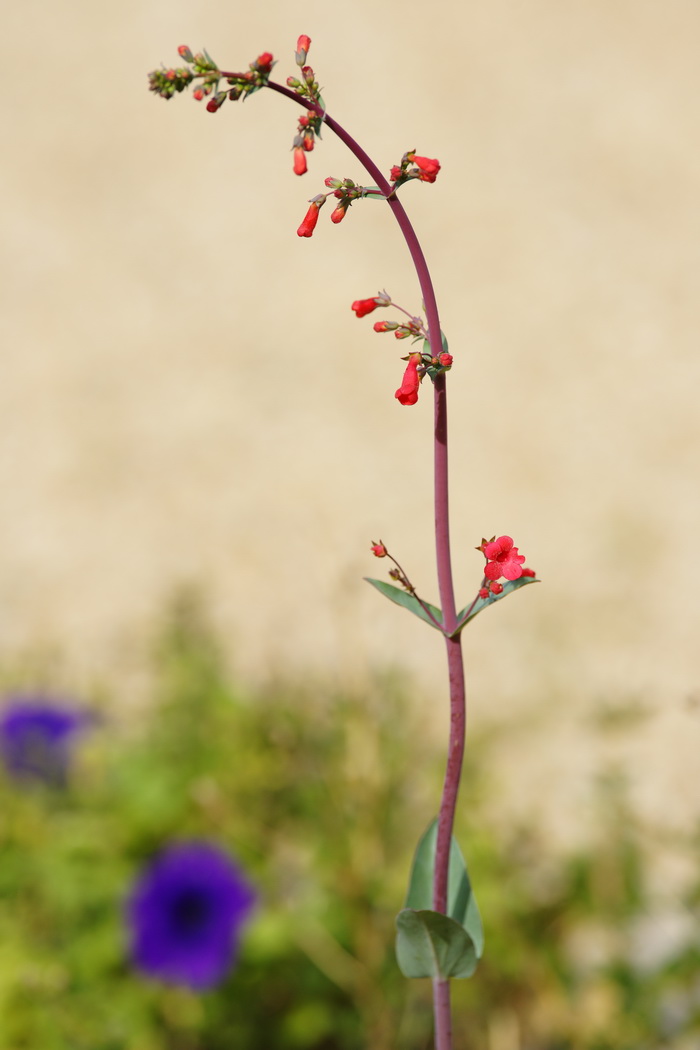 |
| Background blur, F/5.6 |
The full resized images above show real world background blur focused somewhat close at F/2.8 for the top shot, and F/5.6 for the bottom shot. These shots look even smoother than the crops, because I’m not deliberately trying to bring out the most extreme examples, like tree leaves against a bright sky.
Light fall-off.
Light fall-off or corner shading is not noticeable in real pictures at any focal length or aperture using an APS-C camera. Close focusing results in a little more light fall-off than at longer distances at F/2.8, both full frame and APS-C, but again, it’s not noticeable in real use.
Below are crops from the
image centers and corners.
|
F/2.8 center
|
F/2.8 corner
|
|
|
|
|
F/4 center
|
F/4 corner
|
|
|
|
|
F/5.6 center
|
F/5.6 corner
|
|
|
|
|
F/8 center
|
F/8 corner
|
|
|
|
|
F/11 center
|
F/11 corner
|
|
|
|
These images were taken at or near infinity, and the F/2.8 crop shows a little soft, but look at just how sharp the F/4-5.6 shots are. The corners appear fairly sharp at large apertures, but do respond to stopping down, the F/8 shot looks to be the sharpest, and F/11 softens a bit in both the center and corners. Don’t mind the shadow changes on the palm tree, the wind was blowning this day. There is heat shimmer here, so it’s hard to tell the difference in sharpness in some areas of the crops.
Let’s check out the macro capabilities of this lens.
Below, check out the cropped portion of the full image, click for full crop (251kb). The sample shot was taken with the
Sony A 700 12.2MP camera. The subject is a standard US stamp, 0.87″x 1.0″ or 22mm x 25mm. Also, note the macro shot was taken as close to the subject as focusing allowed; in this case 65.6″ (1666mm), measured from the front of the lens barrel to the subject.
This lens has a reproduction size of 0.18x which is about average for today’s long telephoto lenses, and it produced a very sharp shot of the postage stamp at F/5.6. As a side note; the “1996” on the bottom left of the stamp measures a mere 1mm wide.
 |
| As close as you can get. F/5.6. Click for larger image |
Full frame results using the Sony A900 below.
Check out the differences when using a film or full frame camera below. I’m only pointing out the noticeable issues as compared to the APS-C bodies, so if I don’t show it here, the results are not significantly different enough to warrant posting an additional set of images in this section.
Light fall-off
Light fall-off is only slightly stronger with full frame coverage when used wide open. This isn’t noticeable in real pictures.
This image comes from the last 700 pixels of the middle/right side. I see a very small amount of lateral color fringing around the white pole and along the wall cap, but overall the control is excellent, especially for full frame coverage.
Corner samples next.
|
F/2.8 center
|
F/2.8 corner
|
|
|
|
|
F/4 center
|
F/4 corner
|
|
|
|
|
F/5.6 center
|
F/5.6 corner
|
|
|
|
|
F/8 center
|
F/8 corner
|
|
|
|
|
F/11 center
|
F/11 corner
|
|
|
|
Ironically, the full frame corners appear to sharpen up about as well as the APS-C crops, at the same apertures. This is a boring scene, but the fine texture of the house and tree branches do a good job at showing that the sharpness increases seen here are about the same as the indoor crops in the comparison review. There is some heat shimmer here if you look closely.
Distortion below.
 |
| slight pincushion distortion on A900 |
There is minor pincushion distortion with full frame coverage and the amount doesn’t seem to change between close and long distance focusing. The arc segment is even across the frame, and easy to correct in post processing.
Flare and ghosting.
|
F/5.6, sun in shot, offset
|
F/5.6 sun out of shot by a third of a frame
|
|
|
|
The left shot shows a green and multi-colored blob at F/5.6. At F/2.8, (not shown) I see a red blob with a red arc just visible. When the sun is out of the shot there is somewhat heavy glare, but typical for a telephoto lens. No problems with the sun centered. The hood was used for these shots. Full resized images. Ignore the power lines and foreground clutter, I was pressed for time and just pulled off the road before the sun went down.
|
Conclusion.
There isn’t much to not like about the Sony 300mm F/2.8 SSM G lens. If you nit pick, you could say the AF system isn’t as fast as one might want, or the price is too high compared to Canon or Nikon, but without direct comparisons, you don’t know how those two perform, and whether or not the Sony is worth the extra money. If you look closely, you may conclude that F/2.8 is a little soft, but if you go here, you’ll see that the Sony 300mm SSM G is sharper at F/2.8 than the Sony 70-300mm SSM G lens is at any aperture!! The Sony 300mm F/2.8 is stunningly sharp at F/4-5.6, and will put all other Sony lenses that provide 300mm to shame.
Ultimately, the super expensive Sony 300mm F/2.8 SSM G lens is for the photographer that’s being paid a lot of cash to take high quality images at fast action, low-light type venues. However, people photographers will really like this lens when distance and a smooth background blur are important. Rich amateurs will buy this lens, use it a few times, tire of the heft, then put it in the closet where it will stay. They will not loan it to other people, or sell it. After their demise, their children will inherit it, then sell it and buy something more useful.
An alternative to the Sony 300mm F/2.8 SSM G might be the Sony 70-400mm F/4-5.6 SSM G. Obviously it’s two stops slower, and bokeh is sometimes harsh at the long end, (depends on focusing distance), however contrast seems almost as good, it’s more versatile, and provides a little more detail using the 400mm end. For us poor folk, this lens is the best option.
















































